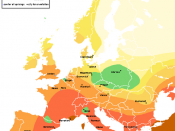Since the reign of Emperor Justinian in 542 A.D., man has one unwelcome organism along for the ride, Yersinia pestis. This is the bacterium more commonly know as the Black Death, the plague. Plague is divided into three biotypes, each associated with one of three major pandemics occurring in history. Each of these biotypes are then divided into three distinct types, classified by method of infection.
The most widely know is bubonic, an infection of plague that resides in the lymph nodes, causing them to swell. The Black Death of the 14th century was mainly of this type. Bubonic plague is commonly spread through fleas that have made a meal from an infected Rattus rattus. In the American and Canadian west, from Texas and Oklahoma in the east to the Pacific Ocean in the west, it is most often transmitted from species of squirrels. The last occurrence of transmissions from rats to people, or people to people in the United States occurred in 1924 in Los Angeles.
In that epidemic there were 32 cases of pneumonic plague with 31 fatalities. Since then there have been around 16 cases a year in the United States, most connected with rock squirrels and its common flea Oropsylla montana.
The most dangerous type of plague is pneumonic. It can be spread through aerosol droplets released through coughs, sneezes, or through fluid contact. It may also become a secondary result of a case of untreated bubonic or septicemic plague. Although not as common as the bubonic strain, it is more deadly. It has an untreated mortality rate on nearly 100%, as compared to 50% untreated mortality for bubonic plague. It attacks the respiratory track, furthering the cycle.
The third type of plague is septemic. It is spread by direct bodily fluid contact.


